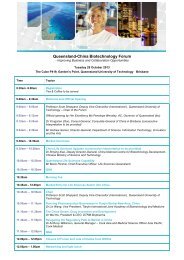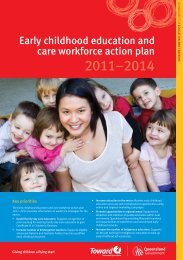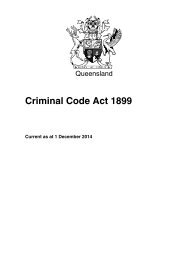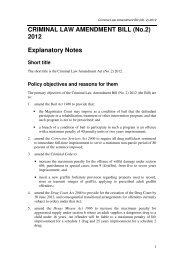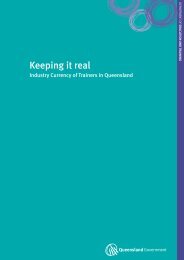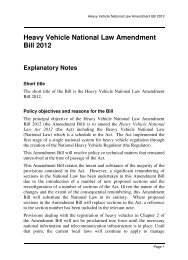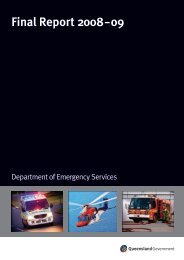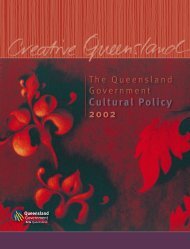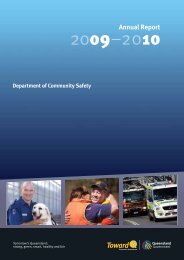Queensland Life Sciences Industry Report 2012 (PDF, 3.5MB)
Queensland Life Sciences Industry Report 2012 (PDF, 3.5MB)
Queensland Life Sciences Industry Report 2012 (PDF, 3.5MB)
You also want an ePaper? Increase the reach of your titles
YUMPU automatically turns print PDFs into web optimized ePapers that Google loves.
<strong>Queensland</strong> <strong>Life</strong> <strong>Sciences</strong> <strong>Industry</strong> <strong>Report</strong> <strong>2012</strong><br />
58<br />
In an early 2011 article, David Blake, Co-editor of BioShares<br />
wrote:<br />
“The ASX-listed biotech sector has gone through a period of<br />
tremendous transformation in the last two years as a dozen<br />
or more companies have matured into successful companies,<br />
generating revenues or verging on having products registered.<br />
At the same time upwards of 30 have had to close their<br />
doors or significantly change their business….However, with<br />
the Nasdaq Biotech Index, …showing a very strong uptrend,<br />
perhaps biotech, not just in the US, but in Australia and<br />
elsewhere is about to be very popular with investors again.” 89<br />
Some of the deals that will have contributed to positive<br />
industry sentiment include the following:<br />
Cephalon offered to pay Mesoblast $130 million upfront<br />
and another $220 million to acquire a nearly 20 per<br />
cent stake in the company in December 2010. The total<br />
deal value, should Mesoblast achieve development and<br />
commercial milestones, could reach US$1.7 billion.<br />
Acrux licenced its testosterone treatment to Eli Lilly in<br />
March 2010 in a deal worth up to US$335 million plus<br />
potential royalties of about US$220 million.<br />
Qiagen acquired all the ordinary shares in Australian<br />
diagnostics company Cellestis Ltd in August 2011 in<br />
a deal worth $341 million.<br />
9.2 Outlook — Barriers, Risks and Challenges<br />
9.2.1 Opportunities for <strong>Industry</strong> Expansion<br />
Survey participants (82) commented on strategies to assist<br />
expansion of the industry. Respondents selected from ten<br />
options including an ‘Other’ option (Table 52).<br />
TABLE 52: Areas that will assist expansion of the<br />
<strong>Life</strong> <strong>Sciences</strong> <strong>Industry</strong><br />
Rank Area Proportion<br />
of total<br />
responses<br />
1 Improved industry representation 17%<br />
2 Government organisations becoming early<br />
adopters of <strong>Queensland</strong> innovations<br />
15%<br />
3 <br />
research or manufacturing facilities<br />
<br />
and educational institutions<br />
12%<br />
5 Increased foreign investment into Australia 10%<br />
6 <br />
<br />
9%<br />
8 Skills enhancement through university<br />
courses<br />
8%<br />
9 Improved engagement between clinicians<br />
and researchers<br />
3%<br />
- Other (see below) 5%<br />
Responses (direct quotes shown) in the ‘Other’ category<br />
included:<br />
Leveraging the skills and professional networks that exist<br />
Trade base and support just to keep R&D and<br />
manufacture alive at all<br />
Scholarships to enhance skills development in industry<br />
Grants for collaboration with SMEs<br />
Reduced regulatory framework<br />
Changes to investment rules to allow investment capital<br />
to flow to commercial R&D organisations<br />
Reinstate Commercial Ready Program; abolish payroll<br />
tax for R&D/manufacturing firms<br />
Maintaining staff capability as a large cohort move<br />
towards retirement over the next 10 years<br />
Several respondents offered comments (direct quotes)<br />
on roles for government in encouraging expansion of<br />
the <strong>Life</strong> <strong>Sciences</strong> <strong>Industry</strong>:<br />
“Bet on the innovators — with real money, not just moral<br />
support or programs which require innovators to spend<br />
money on other researchers”<br />
“Very important that Government do not encroach on<br />
successful commercial entities already established in<br />
<strong>Queensland</strong> such as contract manufacturing, or building<br />
such facilities [where they] already exist. Very important<br />
to train researchers [on] how to commercialise research<br />
outcomes or have systems in place that allow publicly<br />
funded research to be commercialised for [the]<br />
public good.”<br />
9.2.2 Barriers to Future Income Growth — Access to Capital<br />
In the 2009 survey, a lack of access to capital was identified<br />
as the most significant barrier to future growth and the<br />
greatest risk/challenge facing organisations. This is not a<br />
new concern, with limited access to finance or capital also<br />
identified as the major barrier to growth by respondents<br />
to the <strong>Queensland</strong> TMD Survey in 2007. Access to capital<br />
is an issue that affects companies right across the<br />
Australian Biotechnology <strong>Industry</strong> 90 as well as those active<br />
in innovation in any Australian industry. For innovative<br />
Australian companies, limited access to funds and skilled<br />
personnel were the two most commonly identified barriers<br />
to innovation in an ABS study published in 2010. 91<br />
A similar situation is evident in many international <strong>Life</strong><br />
<strong>Sciences</strong> industries, including the USA, Canada and New<br />
Zealand. Jones Lang LaSalle in a <strong>Life</strong> <strong>Sciences</strong> Cluster<br />
<strong>Report</strong> 92 noted that:<br />
“investment capital will be the biggest hurdle for Canada’s<br />
emerging <strong>Life</strong> <strong>Sciences</strong> sector. The recession reduced spending<br />
in the sector and although venture capital returned in 2011,<br />
it remains in short supply.”<br />
89 D Blake, ‘Will The IPO Market Open For Australian Biotechs in 2011?’, AFG Venture Group Dispatches.<br />
90 AusBiotech, ‘Biotechnology <strong>Industry</strong> Position Survey’, January <strong>2012</strong><br />
91 Australian Bureau of Statistics 8158 — Innovation in Australian businesses, 2008-09, quoted in Australian Government, ‘Australian Innovation System<br />
<strong>Report</strong> 2011’acessed at http://www.innovation.gov.au/AIS<strong>Report</strong>.<br />
92 Jones Lang LaSalle, ‘<strong>Life</strong> <strong>Sciences</strong> Cluster <strong>Report</strong>, Global 2011’; accessed 4th July <strong>2012</strong>. www.joneslanglasalle.com/ResearchLevel1/Global_<strong>Life</strong>%20<br />
<strong>Sciences</strong>%20Cluster%20<strong>Report</strong>_2011_gb.pdf.



